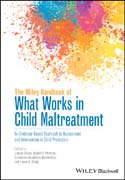
The Wiley Handbook of What Works in Child Maltreatment: An Evidence–Based Approach to Assessment and Intervention in Child Protection
Dixon, Louise
Craig, Leam A.
Perkins, Daniel F.
Hamilton–Giachritsis, Catherine
A comprehensive guide to empirically supported approaches for child protection cases The Wiley Handbook of What Works in Child Maltreatment offers clinicians, psychologists, psychiatrists and other professionals an evidence–based approach to best professional practice when working in the area of child protection proceedings and the provision of assessment and intervention services in order to maximize the well–being of young people. It brings together a wealth of knowledge from expert researchers and practitioners, who provide a comprehensive overview of contemporary work informing theory, assessment, service provision, rehabilitation and therapeutic interventions for children and families undergoing care proceedings. Coverage includes theoretical perspectives, insights on the prevalence and effects of child neglect and abuse, assessment, children s services, and interventions with children, victims and families. INDICE: About the editors .Notes on Contributors .Foreword .Acknowledgements .1 Overview and structure of the book .PART 1: RESEARCH AND THEORETICAL PERSPECTIVES .2 Child abuse and neglect: Prevalence and incidence .3 Child abuse and neglect: Ecological perspectives .4 Fatal child maltreatment .5 Psychological, Economic, and Physical Health Consequences of Child Maltreatment .6 The neurobiology and genetics of childhood maltreatment .7 Intimate partner violence and child maltreatment .PART II: CHILDREN?S SERVICES AND PUBLIC HEALTH APPROACHES TO PREVENTION .8 Implications of children s services policy on child abuse and neglect in England .9 Children s services: Toward effective child protection .10 using the formal pre–proceddings tp prevent or prepare for casre proceedings .11 The prevention of child maltreatment: The case for a public health approach to behavioural parenting intervention .12 WW to prevent the sexual exploitation of children and youth .PART III: ASSESSMENT .13 Evidence based assessments of children and families: Safeguarding Children Assessment and Analysis Framework .14 Utilising an attachment perspective in parenting assessment .15 Evidence based and developmentaly appropriate forensic interviewing of children .16 Considering parental risk in parenting (child custody) evaluation cases involvingchild sexual exploiation material .17 Assessments in child care proceedings: Observations in practice .PART IV: INTERVENTIONS WITH CHILDREN AND Families .18 Evidence–based approaches to empower children and families at–risk for child physical abuse to overcome abuse and violence .19 Effective therapies for children and nonoffending caregivers in the aftermath of child sexual abuse or other traumas 20 Effectiveness of cognitive and behavioural group based parenting programmes to enhance child protective factors and reduce risk factors for maltreatment .21 critical factors in the successful implementation of evidence–based parenting programmes: Fidelity, adaption and promoting quality .22 School based resilience prevention and interventin of CM .23 Using Assessment of Attachment in Child Care Proceedings to Guide Intervention .PART V: NOVEL INTERVENTIONS WITH FAMILIES .24 Working systemically with families with intimate partner violence .25 Working with nonoffending parents in cases of child sexual abuse .26 Working with Parents with Intellectual Disabilities in childcare proceedings .27 Working with parents with a diagnosis of personality disorder .28 Working with parents who use drugs and alcohol
- ISBN: 978-1-118-97617-3
- Editorial: Wiley–Blackwell
- Encuadernacion: Cartoné
- Páginas: 536
- Fecha Publicación: 09/06/2017
- Nº Volúmenes: 1
- Idioma: Inglés
- Inicio /
- /
